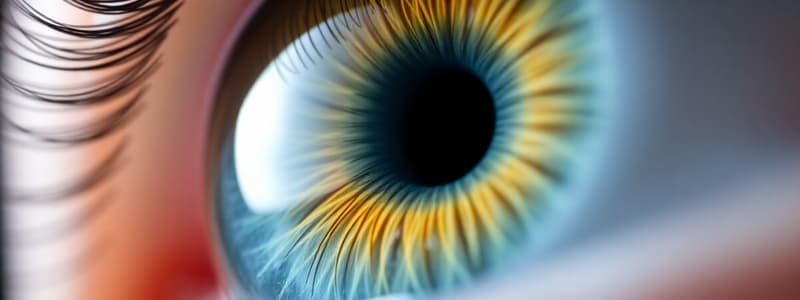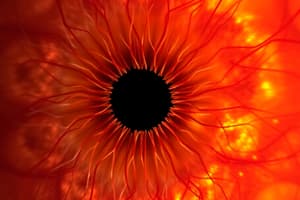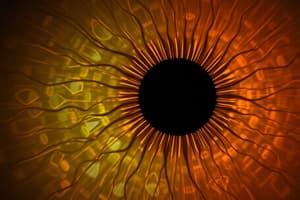Podcast
Questions and Answers
Why is our ability to discern fine details greater in daylight compared to nighttime?
Why is our ability to discern fine details greater in daylight compared to nighttime?
- Because cones, concentrated in the fovea, are responsible for daylight vision and have a higher density than rods. (correct)
- Because rods, responsible for night vision, have a one-to-one neural connection in the fovea centralis, allowing for high-resolution detail.
- Because rods, concentrated in the fovea, are responsible for daylight vision and have a higher density than cones.
- Because cones, responsible for color vision, are more sensitive to blue-green light, which helps in discerning details during the day.
What is the functional consequence of multiple rods converging onto a single nerve fiber?
What is the functional consequence of multiple rods converging onto a single nerve fiber?
- Improved ability to resolve fine details in peripheral vision.
- Reduced light sensitivity due to signal dilution.
- Increased sensitivity to motion in the periphery. (correct)
- Enhanced color perception in low-light conditions.
If a person transitions from bright sunlight into a dimly lit room, what accounts for the initial difference in adaptation speed between cones and rods?
If a person transitions from bright sunlight into a dimly lit room, what accounts for the initial difference in adaptation speed between cones and rods?
- Cones adapt more quickly because they are more sensitive and have a faster response time in the initial stages of dark adaptation. (correct)
- Rods adapt more quickly because they are initially more sensitive to yellow-green light and do not require as much pigment regeneration.
- Rods adapt quickly initially, but take longer to fully adapt because they have to process the information through shared nerve fibers.
- Cones adapt more slowly due to their lower density and the longer time it takes for the visual pigments to regenerate.
An artist is creating a painting that aims to mimic human vision in low-light conditions. Which strategy would best simulate the properties of rod-dominant vision?
An artist is creating a painting that aims to mimic human vision in low-light conditions. Which strategy would best simulate the properties of rod-dominant vision?
A researcher is developing a new type of display screen designed to minimize eye strain in prolonged use. Considering the properties of cones and rods, what design feature would be most effective?
A researcher is developing a new type of display screen designed to minimize eye strain in prolonged use. Considering the properties of cones and rods, what design feature would be most effective?
Flashcards
What are cones?
What are cones?
Photoreceptor cells in the eye responsible for color vision and fine details in daylight.
What are rods?
What are rods?
Photoreceptor cells in the eye responsible for night and peripheral vision.
Individual vs. grouped signaling in photoreceptors
Individual vs. grouped signaling in photoreceptors
Cones have individual neural links, providing high detail resolution. Rods pool signals, sacrificing detail.
Peak Sensitivity of Cones
Peak Sensitivity of Cones
Signup and view all the flashcards
Dark Adaptation Time: rods vs. cones
Dark Adaptation Time: rods vs. cones
Signup and view all the flashcards
Study Notes
- There are approximately 6.5 million cones in each eye
- Cones are used for daylight vision, enabling the perception of fine details and color recognition
- Cones are primarily located in the fovea centralis
- Each cone has its own direct neural connection to the brain
- The density of cones determines the level of detail the eye can resolve
- Cones have a peak sensitivity at around 550 nm, within the yellow-green region, coinciding with the maximum solar spectrum on Earth's surface
- Cones adapt to darkness rapidly, in about 5 minutes
Rods
- Each eye contains approximately 120 million rods
- Rods facilitate night vision and peripheral vision
- Rods are distributed across most of the retina, with maximum density at a 20° angle from the vision axis
- Hundreds of rods send information to a single nerve fiber
- Rods have a limited ability to distinguish between closely spaced light sources
- Rods exhibit maximum sensitivity to blue-green light, around 510 nm
- Rods continue to adapt to darkness over a longer period, from 30 to 60 minutes
Studying That Suits You
Use AI to generate personalized quizzes and flashcards to suit your learning preferences.




